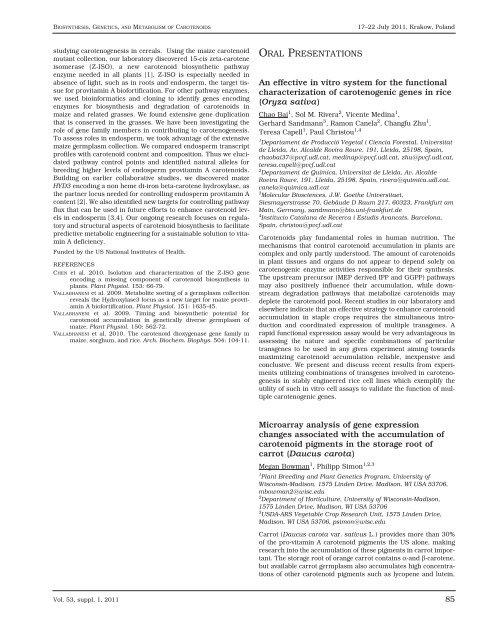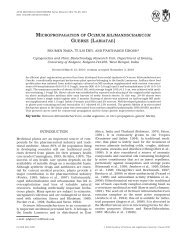ACTA BIOLOGICA CRACOVIENSIA
ACTA BIOLOGICA CRACOVIENSIA
ACTA BIOLOGICA CRACOVIENSIA
You also want an ePaper? Increase the reach of your titles
YUMPU automatically turns print PDFs into web optimized ePapers that Google loves.
BIOSYNTHESIS, GENETICS, AND METABOLISM OF CAROTENOIDS<br />
studying carotenogenesis in cereals. Using the maize carotenoid<br />
mutant collection, our laboratory discovered 15-cis zeta-carotene<br />
isomerase (Z-ISO), a new carotenoid biosynthetic pathway<br />
enzyme needed in all plants [1]. Z-ISO is especially needed in<br />
absence of light, such as in roots and endosperm, the target tissue<br />
for provitamin A biofortification. For other pathway enzymes,<br />
we used bioinformatics and cloning to identify genes encoding<br />
enzymes for biosynthesis and degradation of carotenoids in<br />
maize and related grasses. We found extensive gene duplication<br />
that is conserved in the grasses. We have been investigating the<br />
role of gene family members in contributing to carotenogenesis.<br />
To assess roles in endosperm, we took advantage of the extensive<br />
maize germplasm collection. We compared endosperm transcript<br />
profiles with carotenoid content and composition. Thus we elucidated<br />
pathway control points and identified natural alleles for<br />
breeding higher levels of endosperm provitamin A carotenoids.<br />
Building on earlier collaborative studies, we discovered maize<br />
HYD3 encoding a non heme di-iron beta-carotene hydroxylase, as<br />
the partner locus needed for controlling endosperm provitamin A<br />
content [2]. We also identified new targets for controlling pathway<br />
flux that can be used in future efforts to enhance carotenoid levels<br />
in endosperm [3,4]. Our ongoing research focuses on regulatory<br />
and structural aspects of carotenoid biosynthesis to facilitate<br />
predictive metabolic engineering for a sustainable solution to vitamin<br />
A deficiency.<br />
Funded by the US National Institutes of Health.<br />
REFERENCES<br />
CHEN et al. 2010. Isolation and characterization of the Z-ISO gene<br />
encoding a missing component of carotenoid biosynthesis in<br />
plants. Plant Physiol. 153: 66-79.<br />
VALLABHANENI et al. 2009. Metabolite sorting of a germplasm collection<br />
reveals the Hydroxylase3 locus as a new target for maize provitamin<br />
A biofortification. Plant Physiol. 151: 1635-45.<br />
VALLABHANENI et al. 2009. Timing and biosynthetic potential for<br />
carotenoid accumulation in genetically diverse germplasm of<br />
maize. Plant Physiol. 150: 562-72.<br />
VALLABHANENI et al. 2010. The carotenoid dioxygenase gene family in<br />
maize, sorghum, and rice. Arch. Biochem. Biophys. 504: 104-11.<br />
Vol. 53, suppl. 1, 2011<br />
ORAL PRESENTATIONS<br />
An effective in vitro system for the functional<br />
characterization of carotenogenic genes in rice<br />
(Oryza sativa)<br />
Chao Bai1 , Sol M. Rivera2 , Vicente Medina1 ,<br />
Gerhard Sandmann3 , Ramon Canela2 , Changfu Zhu1 ,<br />
Teresa Capell1 , Paul Christou1,4 1Departament de Producció Vegetal i Ciencia Forestal, Universitat<br />
de Lleida, Av. Alcalde Rovira Roure, 191, Lleida, 25198, Spain,<br />
chaobai37@pvcf.udl.cat, medinap@pvcf.udl.cat, zhu@pvcf.udl.cat,<br />
teresa.capell@pvcf.udl.cat<br />
2Departament de Química, Universitat de Lleida, Av. Alcalde<br />
Rovira Roure, 191, Lleida, 25198, Spain, rivera@quimica.udl.cat,<br />
canela@quimica.udl.cat<br />
3Molecular Biosciences, J.W. Goethe Universitaet,<br />
Siesmayerstrasse 70, Gebäude D Raum 217, 60323, Frankfurt am<br />
Main, Germany, sandmann@bio.uni-frankfurt.de<br />
4Institucio Catalana de Recerca i Estudis Avancats, Barcelona,<br />
Spain, christou@pvcf.udl.cat<br />
Carotenoids play fundamental roles in human nutrition. The<br />
mechanisms that control carotenoid accumulation in plants are<br />
complex and only partly understood. The amount of carotenoids<br />
in plant tissues and organs do not appear to depend solely on<br />
carotenogenic enzyme activities responsible for their synthesis.<br />
The upstream precursor (MEP derived IPP and GGPP) pathways<br />
may also positively influence their accumulation, while downstream<br />
degradation pathways that metabolize carotenoids may<br />
deplete the carotenoid pool. Recent studies in our laboratory and<br />
elsewhere indicate that an effective strategy to enhance carotenoid<br />
accumulation in staple crops requires the simultaneous introduction<br />
and coordinated expression of multiple transgenes. A<br />
rapid functional expression assay would be very advantageous in<br />
assessing the nature and specific combinations of particular<br />
transgenes to be used in any given experiment aiming towards<br />
maximizing carotenoid accumulation reliable, inexpensive and<br />
conclusive. We present and discuss recent results from experiments<br />
utilizing combinations of transgenes involved in carotenogenesis<br />
in stably engineered rice cell lines which exemplify the<br />
utility of such in vitro cell assays to validate the function of multiple<br />
carotenogenic genes.<br />
Microarray analysis of gene expression<br />
changes associated with the accumulation of<br />
carotenoid pigments in the storage root of<br />
carrot (Daucus carota)<br />
Megan Bowman 1 , Philipp Simon 1,2,3<br />
17–22 July 2011, Krakow, Poland<br />
1 Plant Breeding and Plant Genetics Program, University of<br />
Wisconsin-Madison, 1575 Linden Drive, Madison, WI USA 53706,<br />
mbowman2@wisc.edu<br />
2 Department of Horticulture, University of Wisconsin-Madison,<br />
1575 Linden Drive, Madison, WI USA 53706<br />
3 USDA-ARS Vegetable Crop Research Unit, 1575 Linden Drive,<br />
Madison, WI USA 53706, psimon@wisc.edu<br />
Carrot (Daucus carota var. sativus L.) provides more than 30%<br />
of the pro-vitamin A carotenoid pigments the US alone, making<br />
research into the accumulation of these pigments in carrot important.<br />
The storage root of orange carrot contains α-and β-carotene,<br />
but available carrot germplasm also accumulates high concentrations<br />
of other carotenoid pigments such as lycopene and lutein,<br />
85












